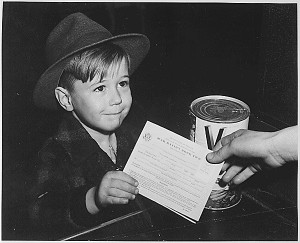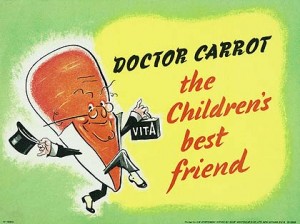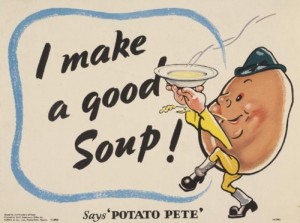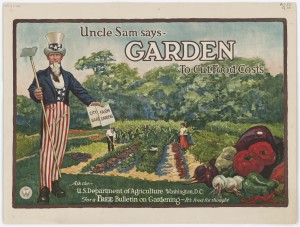 Despite the fact that some foods were scarce and others were rationed, World War II eating patterns resulted in a more balanced diet, better nutrition, lower cholesterol, and reduction in weight.
Despite the fact that some foods were scarce and others were rationed, World War II eating patterns resulted in a more balanced diet, better nutrition, lower cholesterol, and reduction in weight.
The Kitchen Front was an integral part of the War effort, mobilized by propaganda from government agencies as well as radio broadcasts, magazines, educational organizations and newspapers. Everyone was challenged to use their ingenuity and imagination to extend the food supply. And they did–nothing was wasted.
- Mashed potatoes were substituted for flour whenever possible
- Equal parts of melted butter or margarine and mashed potatoes were mixed together to make a spread for sandwiches
- Syrup was made from sugar beets to sweeten drinks and puddings
- Edible weeds such as dandelions and nettles supplemented vegetables
- Drippings from roasts were used as fat
- Apple peelings were not thrown away–they were boiled in water to make a lemon-flavored liquid
- Heavy cream was churned into butter
- Grated potatoes were soaked in water and allowed to ferment to substitute for yeast
- Stale bread was dipped in and out of cold water or milk, placed on a greased tin and baked in a moderate oven until crisp
- Dried eggs reconstituted with water replaced whole eggs whenever possible; dried skim milk was sprinkled on stewed fruit as a sweetener
- Restaurants served meatless meals such as vegetable cutlets, nut burgers, cheese-less macaroni and cheese, tripe creole or organ meats like kidney stew
Dr. Carrot and Potato Pete
 Two vegetables that emerged as “superstars” were carrots and potatoes. They were in plentiful supply, they were adaptive to new uses as substitutes for scarce ingredients and they were nutritious. To promote their use, the Ministry of Food in England created two cartoon characters: Dr. Carrot and Potato Pete.
Two vegetables that emerged as “superstars” were carrots and potatoes. They were in plentiful supply, they were adaptive to new uses as substitutes for scarce ingredients and they were nutritious. To promote their use, the Ministry of Food in England created two cartoon characters: Dr. Carrot and Potato Pete.
Dr. Carrot, wearing spectacles and spats, carried a bag inscribed with VIT A to suggest that the high carotene content helped night vision. Pilots were fed extra amounts of carrots and the Food Ministry in England went so far as to suggest that the night flying success of the RAF was due to eating carrots.
Many new recipes using carrots were created including carrot top and potato soup, grated carrot sandwiches, carrot pudding, carrot fudge, carrot cookies, curried carrots, carrot marmalade and even a drink called carrotlade.
 As for Potato Pete, he was praised as an energy food that could be used in many ways, not only because it was rich in Vitamin C, but also because it was so versatile. Mashed potatoes substituted for flour in many recipes including puddings, scones, cakes, soups and salad dressings and even eggless mayonnaise.
As for Potato Pete, he was praised as an energy food that could be used in many ways, not only because it was rich in Vitamin C, but also because it was so versatile. Mashed potatoes substituted for flour in many recipes including puddings, scones, cakes, soups and salad dressings and even eggless mayonnaise.
Rationed foods: milk, eggs, bacon, butter, cooking fat, jam, tea
Everyone was encouraged to eat one pound of potatoes every day.
Then there was SPAM, a non-rationed canned luncheon meat of chopped pork shoulder, ham, salt, water, sugar, sodium nitrite and modified potato starch with a gelatinous glaze. It could be eaten cold or warm, fried, battered or even “glamorized” as a Spam creole. Because it was not rationed, Spam was ubiquitous, consumed on the war front as well as the kitchen front.
Servicemen referred to it as “the ham that failed the physical.”
Victory Gardens
To supplement the supply of vegetables, public service booklets and posters encouraged the kitchen front to grow their own.  Victory gardens were planted in every spare patch of ground from public parks to play grounds, golf courses, vacant lots, school grounds, front lawns, and even window boxes. Not only did they grow their own, but some people also canned any surplus, since the shortage of tin had limited the amount of canned goods they could buy.
Victory gardens were planted in every spare patch of ground from public parks to play grounds, golf courses, vacant lots, school grounds, front lawns, and even window boxes. Not only did they grow their own, but some people also canned any surplus, since the shortage of tin had limited the amount of canned goods they could buy.
Foods in short supply: meat, sugar, tea, coffee, chocolate
In addition to green vegetables, the kitchen front was encouraged to raise a few chickens and rabbits and even a small pig, space permitting. Stores such as Macy’s in New York sold baby chicks and rabbits as well as incubators, and offered instructions on how to raise them.
This had its challenges: Grain for the hens was scarce and there were restrictions. You couldn’t have more than eight rabbits and if you had more than 24 hens, it was considered a commercial enterprise and in England one was required to sell the eggs to packing stations.
.
On the other hand, one small pig could be raised in a garden pigsty 300 yards from the house and fattened up with household scraps. When it came time to slaughter they had to obtain a license and call the butcher to deal with it . Every part of the pig was edible. Neighborhood Pig clubs were formed to share the meat, which had to be processed and cured. But there was one caveat: any family getting a piece of the pig had to forfeit one person’s bacon ration for a year.
One of the classic food rationing recipes was LORD WOOLTON PIE, named in honor of Lord Woolton, Minister of Food in England
1 pound each of diced potatoes, cauliflower, swedes (rutabaga) and carrots
3 or 4 spring onions
1 tsp vegetable extract
1 tsp. oatmeal
a little chopped parsley
½ pound cooked, sliced potatoes or wholemeal pastry for topping
Place the diced vegetables, spring onions, vegetable extract and oatmeal into a saucepan, add just enough water to cover and cook for 10 minutes, stirring occasionally. Allow to cool. Put the mixture into a pie dish and sprinkle with parsley. Cover with the crust of potatoes or wholemeal pastry. Bake in a moderate oven until the topping is nicely browned and serve hot with gravy.
Leave a Reply